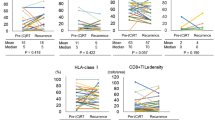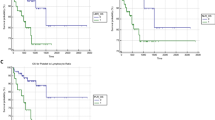Abstract
Squamous cell carcinomas of the head and neck (SCCHN) are excellent candidates for local immunotherapy owing to their accessibility and their infiltration by mononuclear cells that are susceptible to immunomodulation. A response rate of 25–60% has been reported for treatment with natural IL-2 or a mixture of natural lymphokines. In the present study, biopsies and posttreatment excision specimens from nine patients with operable SCCHN treated systemically with a variety of immunomodulators and locally with natural lymphokines (multikine, CelSci) were analyzed in an attempt to correlate clinical response to histopathological and immunohistochemical changes. Formalin-fixed, paraffin-embedded tissues were stained with antibodies against lymphocytes (CD45, CD3, CD4, CD8, CD20), macrophages (CD68) including dendritic cells (S-100), markers for lymphocyte activation (CD30, HLA-DR), natural killer cells (CD56 and CD57), beta-2-microglobulin and keratin. One patient showed a complete response to treatment and two a partial response. Tumor size was significantly smaller after therapy. Clinical and pathological regression were more prominent in the smaller tumors. Numerous macrophages, both mononucleated and multinucleated, were present along the tumor-stroma interface in the posttreatment specimens of seven patients, most prominently in the three patients with tumor regression. The increase in the number of CD68+ and S-100+ macrophages after treatment was statistically significant. Lymphocytic infiltrates, which showed some increase following treatment, were composed of a mixture of T and B lymphocytes, the former mostly in contact with the tumor and the latter placed more peripherally. CD8+ lymphocytes extended into the tumors, whereas CD4+ lymphocytes showed minimal extension. Intensity of beta-2-microglobulin staining in tumors was significantly higher following therapy and associated with a better outcome. The marked increase in macrophages following treatment may indicate that the macrophage plays a major role in tumor recognition, destruction and clearance. An increase in the number of macrophages in a posttreatment specimen may indicate immunoresponsiveness.




Similar content being viewed by others
References
Myers JN (1999) The use of biological therapy in cancer of the head and neck. Curr Probl Cancer 23: 106–134
Cortesina G, Bussi M, Morra B, Beatrice F, Cavallo GF, Di-Fortunato V, Paggio E, Barioglio MD, Landolfo S, Sartoris A (1983) Evaluation of the immune responsiveness in laryngeal cancer patients with specific and aspecific tests: first results of follow-up in 80 cases. G Batteriol Virol Immunol 76: 173–186
Das SN, Khanna NN (1986). In vivo and in vitro observation of cellular immune parameters in squamous cell carcinoma of the oral cavity and its correlation with tumor load and prognosis. Cancer Invest 4: 207–216
Lundy J, Wanebo H, Pinsky C, Strong E, Oettgen H (1974) Delayed hypersensitivity reactions in patients with squamous cell cancer of the head and neck. Am J Surg 128: 530–533
Saranath D, Mukhopadhyaya R, Rao RS, Fakih AR, Naik SL, Gangal SG (1985) Cell mediated immune status in patients with squamous cell carcinoma of the oral cavity. Cancer 56: 1062–1070
Schantz SP, Brown BW, Lira E, Taylor DL, Beddingfield N (1987) Evidence for the role of natural immunity in the control of metastatic spread of head and neck cancer. Cancer Immunol Immunother 25: 141–145
Veltri RW, Rodman SM, Maxim PE, Baseler MW, Sprinkle PM (1986) Immune complexes, serum proteins, cell-mediated immunity and immune regulation in patients with squamous cell carcinoma of the head and neck. Cancer 57: 2295–2308
Verastegui E, Barrera JL, Zinser J, Del Rio R, Meneses A, De la Garza J, Hadden JW (1997) A natural cytokine mixture (IRX-2) and interference with immune suppression induce immune mobilization and regression of head and neck cancer. Int J Immunopharmacol 19: 619–627
Young RI, Wright MA, Lozano Y, Matthews JR, Benefield J, Prechel MM (1996) Mechanisms of immune suppression in patients with head and neck cancer: influence on the immune infiltrate of the cancer. Int J Cancer 67: 333–338
Hadden JW (1996) Immunology of head and neck cancer: prospects for immunotherapy. Clin Immunother 3: 362–374
Wolf GT, Hudson JL, Peterson KA, Miller HL, McClatchey KD (1986) Lymphocyte subpopulations infiltrating squamous carcinomas of the head and neck. Correlations with extent of tumor and prognosis. Arch Otolaryngol Head Neck Surg 95: 142–152
Forni G, Giovarelli M, Santoni A (1985) Lymphokine-activated tumor inhibition in vivo. I. The local administration of interleukin-2 triggers nonreactive lymphocytes from tumor-bearing mice to inhibit tumor growth. J Immunol 134: 1305–1311
Forni G, Giovarelli M, Santoni A, Modesti A, Forni M (1987) Interleukin-2 activated tumor inhibition in vivo depends on the systemic involvement of host immunoreactivity. J Immunol 138: 4033–4041
Forni G, Cavallo GP, Giovarelli M, Benetton G, Jemma C, Barioglio MG, De-Stefani A, Forni M, Santoni M, Modesti A, Cavallo G, Menzio P, Cortesina G (1988) Tumor immunotherapy by local injection of interleukin-2 and non-reactive lymphocytes. Prog Exp Tumor Res 32: 187–212
Heo DS, Whiteside TL, Johnson JT, Chen KN, Barnes EL, Herberman RB (1987) Long-term interleukin 2-dependent growth and cytotoxic activity of tumor-infiltrating lymphocytes from human squamous cell carcinomas of the head and neck. Cancer Res 47: 6353–6362
Salvadori S, Gansbacher B, Pizzimenti AW, Zierk S (1994) Abnormal signal transducton by T cells of mice with parental tumors is not seen in mice bearing IL-2 secreting tumors. J Immunol 153: 5170–5182
Vose BM, Ferguson R, Moor B (1982) Mitogen responsiveness and inhibitory activity of mesenteric lymph node cells: conditioned medium containing T cell growth factor reverses suppression function. Cancer Immunol Immunother 13: 105–111
Prime SS, Pitigala-Arachchi A, Crane IJ, Rosser TJ, Scully C (1987) The expression of cell surface MHC class I heavy and light chain molecules in pre-malignant and malignant lesions of the oral mucosa. Histopathol 11: 81–91
Vora AR, Rodgers S, Parker AJ, Start R, Rees RC, Murray AK (1997) An immunohistochemical study of altered immunomodulatory molecule expression in head and neck squamous cell carcinoma. Br J Cancer 76: 836–844
Cortesina G, De Stefani A, Giovarelli M, Barioglio MG, Cavallo GP, Jemma C, Forni G (1988) Treatment of recurrent squamous cell carcinoma of the head and neck with low doses of interleukin-2 injected perilymphatically. Cancer 62: 2482–2485
Cortesina G, De Stefani A, Galeazzi E, Cavallo GP, Jemma C, Giovarelli M, Vai S, Forni G (1991) Interleukin-2 injected around tumor-draining lymph nodes in head and neck cancer. Head Neck 13: 125–131
Cortesina G, DeStefani A, Galeazzi E, Cavallo GP, Badellino F, Margarino G, Jemma C, Forni G (1994) Temporary regression of recurrent squamous cell carcinoma of the head and neck is achieved with a low but not with a high dose of recombinant interleukin-2 injected perilymphatically. Br J Cancer 69: 572–576
Mattijssen V, De Mulder PH, Schornagel JH, Verweij J, Van-den Broek P, Galazka A, Roy S, Ruiter DJ (1991) Clinical and immunopathological results of a phase II study of perilymphatically injected recombinant interleukin-2 in locally far advanced, nonpretreated head and neck squamous cell carcinomas. J Immunother 10: 63–68
Meneses A, Verastegui E, Barrera JL, Zinser J, De la Garza J, Hadden JW (1998) Histologic findings in patients with head and neck squamous cell carcinoma receiving perilymphatic natural cytokine mixture (IRX-2) prior to surgery. Arch Pathol Lab Med 122: 447–454
Musiani P, de Campora E, Valitutti S, Castellino F, Calearo C, Cortesina G, Giovarelli M, Jemma C, De Stefani A, Forni G (1989) Effect of low doses of interleukin-2 injected perilymphatically and peritumorally in patients with advanced primary head and neck squamous cell carcinoma. J Biol Response Mod 8: 571–578
Vlock DR, Snyderman CH, Johnson JT, Myers EN, Eibling DE, Rubin JS, Kirkwood JM, Dutcher JP, Adams GL (1994) Phase Ib trial of the effect of peritumoral and intranodal injections of interleukin-2 in patients with advanced squamous cell carcinoma of the head and neck: an eastern cooperative oncology group trial. J Immunother 15: 134–139
Whiteside TL, Letessier E, Hirabayashi H, Vitolo D, Bryant J, Barnes L, Snyderman C, Johnson JT, Myers E, Herberman RB, Rubin J, Kirkwood JM, Vlock DR (1993) Evidence for local and systemic activation of immune cells by peritumoral injections of interleukin 2 in patients with advanced squamous cell carcinoma of the head and neck. Cancer Res 53: 5654–5662
De Stefani A, Valente G, Forni G, Lerda W, Ragona R, Cortesina G (1996) Treatment of oral cavity and oropharynx squamous cell carcinoma with perilymphatic interleukin-2: clinical and pathologic correlations. J Immunother 19: 125–133
Saito T, Kakiuti H, Kuki K, Yokota M, Jinnin T, Kimura T, Fujiwara K, Yoda J, Kunimoto M, Arai H, Tabata T (1989) Clinical evaluation of local administration of RIL-2 in head and neck cancer. Nippon-Jibiinkoka Gakkai Kaiho 92: 1265–1270
Valente G, De Stefani A, Jemma C, Giovarelli M, Geuna M, Cortesina G, Forni G, Palestro G (1990) Infiltrating leukocyte populations and T-lymphocyte subsets in head and neck squamous cell carcinomas from patients receiving perilymphatic injections of recombinant interleukin-2. Mod Pathol 3: 702–708
Berd D, Maguire HC, Mastrangelo MJ (1984) Potentiation of human cell-mediated and humoral immunity by low-dose cyclophosphamide. Cancer 44: 5439–5443
Goodwin JS (1980) Prostaglandin synthetase inhibitors as immunoadjuvants in the treatment of cancer. J Immunopharmacol 2: 397–406
Hadden JW, Endicott J, Baekey P, Skipper P, Hadden EM (1994) Interleukins and contrasuppression induce immune regression of head and neck cancer. Arch Otolaryngol Head Neck Surg 120: 395–403
Barrera JL, Verastegui E, Meneses A, Zinser J, dela Garza J, Hadden JW (2000) Combination immunotherapy of squamous cell carcinoma of the head and neck: a phase 2 trial. Arch Otolaryngol Head Neck Surg 126: 345–351
Saito T, Kawaguti T, Yoda J, Kimura T, Tabata T (1989) Immunohistology of tumor tissue in local administration of recombinant interleukin-2 in head and neck cancer. Nippon Jibiinkoka Kaiho 92: 1271–1276
American Joint Committee on Cancer (AJCC) (1997). Manual for staging of cancer, 5th edn. Lippincott, Philadelphia
Berlinger NT, Lopez C, Good RA (1976) Facilitation or attenuation of mixed leukocyte culture responsiveness by adherent cells. Nature 260: 145–146
Berlinger NT, Hilal EY, Oettgen HF, Good RA (1978) Deficient cell-mediated immunity in head and neck cancer patients secondary to autologous suppressive immune cells. Laryngoscope 88: 470–483
Quan PC, Burtin P (1978) Demonstration of nonspecific suppressor cells in the peripheral lymphocytes of cancer patients. Cancer Res 38: 288–296
Cohen PJ, Lotze MT, Roberts JR, Rosenberg SA, Jaffe ES (1987) The immunopathology of sequential tumor biopsies in patients treated with interleukin-2. Am J Pathol 129: 208–216
Rubin JT, Elwood LJ, Rosenberg SA, Lotze MT (1989) Immunohistochemical correlates of response to recombinant interleukin-2-based immuno-therapy in humans. Cancer Res 49: 7086–7092
Okada K, Yasumura S, Muller-Fleckenstein I, Fleckenstein B, Talib S, Koldovsky U, Whiteside TL (1997) Interactions between autologous CD4+ and CD8+ T lymphocytes and human squamous cell carcinoma of the head and neck. Cell Immunol 177: 35–48
Rossio JL, Ruscetti FW (1988) Immunomodulation of neoplasia by interleukin-2. Prog Exp Tumor Res 32: 174–186
Arany I, Adler-Storthz K, Chen Z, Tyring SK, Brysk MM (1998) Tumor differentiation-dependent local immunity in human head and neck cancer. Cancer Lett 123: 173–176
Schantz SP, Racz T, Ordonez NG, Terry N, Taylor DL, Bugis S, Sacks PG (1990) Differential sensitivity of head and neck cancers to non-major histocompatibility-restricted killer cell activity. J Surg Res 48: 154–164
Rivoltini L, Gambacorti-Passerini C, Squadrelli-Saraceno M, Grosso MI, Cantu G, Molinari R, Orazi A, Parmiani G (1990) In vivo interleukin-2- induced activation of lymphokine-activated killer cells and tumor cytotoxic T cells in cervical lymph nodes of patients with head and neck tumors. Cancer Res 50: 5551–5557
Acknowledgements
The authors thank Gloria Ginzach and Charlotte Sachs of the Editorial Board, Rabin Medical Center, Beilinson Campus, for their assistance.
Author information
Authors and Affiliations
Corresponding author
Additional information
This study is a CISEPO project and was supported in part by the Saul A. Silverman Family Foundation.
Rights and permissions
About this article
Cite this article
Feinmesser, M., Okon, E., Schwartz, A. et al. Histologic and immunohistochemical characterization of tumor and inflammatory infiltrates in oral squamous cell carcinomas treated with local multikine immunotherapy: the macrophage at the front line. Eur Arch Otorhinolaryngol 261, 359–368 (2004). https://doi.org/10.1007/s00405-003-0615-x
Received:
Accepted:
Published:
Issue Date:
DOI: https://doi.org/10.1007/s00405-003-0615-x




